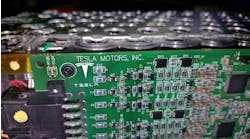As we are exploring the different advanced driver assistance systems (ADAS), our ongoing ADAS series has looked at automatic emergency braking (AEB), long-range radar typically used in adaptive cruise control (ACC), and the forward-facing camera and the multiple roles it plays in ADAS. Today’s installment will take a look at the blind spot detection system.
Blind spot detection systems have been around for a while and are now found on most new vehicles sold in the United states. This simple yet effective ADAS feature alerts the driver that obscured vehicles are in close proximity, and which side of the vehicle they are on.
Typically, blind spot detection systems consist of a radar sensor mounded at each corner of the rear of the vehicle. They are often mounted to the lower quarter panel, rear body panel, or to the inside of the rear bumper cover. You may also find the sensors mounted behind the taillamps or the steps on the corner of steel bumpers found on some vehicles.
Some vehicles have cameras that are used as the inputs for the blind spot system, while others utilize ultrasonic parking sensors either independently or in addition to the radar sensors. For the purpose of this article, we will focus on the commonly found radar sensors used as the inputs for these systems.
The radar sensors transmit a high-frequency radio signal that reflects off objects and returns to the sensor. The time it takes to receive a return signal is used to determine the presence of an object and the vehicle’s distance from that object. Being that these are short-range radar, the distance is less relevant than say the long-range radar for adaptive cruise control (ACC) or automatic emergency braking (AEB) systems. These sensors really just need to be able to identify if there is an object present in the predetermined field of vision.
Generally, the radar sensors are set up as a primary module and secondary. The secondary module communicates to the primary module, which communicates to other systems. If the secondary module detects an object, the secondary module will tell the primary module that it sees an object. The primary module, generally, will then talk to a different module to issue an alert.
When the system is turned on and an object is detected, warnings will be sent to the driver to let them know. These warnings can come in many different forms such as a visual indicator on the side mirrors or dash, an audible alert, a vibration in the steering wheel, and even vibrations in the left or right side of the seat to indicate which side of the vehicle the object was detected.
Often the systems use a combination of these warnings. The exact combination can vary between vehicles and can even be based on the proximity of the detection. Some systems go beyond merely detecting and will steer the vehicle back to its lane if the turn signal is activated and a lane change is initiated while an object is detected in the adjacent lane.
Often you will find that a vehicle equipped with a blind spot detection system will also be equipped with a rear cross traffic system. This is because most rear cross traffic systems utilize the same components used for the blind spot detection systems. Rear cross traffic systems go by many different names, but they all do the same thing. They detect traffic from the left or right rear of the vehicle when the vehicle is shifted into reverse. As stated earlier, sometimes the ultrasonic sensors are utilized in addition to the radar sensors. This typically allows for better detection and warning than with radar sensors alone.
Typically, rear cross traffic systems are not designed to detect smaller objects such a small motorcycle, bicycle, or pedestrian. This does not mean that they won’t detect such objects, it means that they are not designed to, and one should not rely on them to consistently do so.
As these systems are designed to detect objects from the corners of the vehicle, objects approaching directly from behind the vehicle or moving away from the vehicle may not be detected. In addition, due to the limited field of vision, these systems work best in parking scenarios where the vehicle is parked straight in and may not work well in angled parking situations.
Proper mounting of the radar sensors is important. The mounting of the radar sensors may be compromised in a collision, even if the impact is not directly at the sensor. Sensors that mount directly to the back of the bumper cover may break away during a collision, this will often require a replacement of the bumper cover. Radar sensors that are mounted to the body of the vehicle, either directly or on a mounting bracket, can become misaligned from the position they were in when they left the factory. Restoring the radar sensors to their original location is essential.
Some vehicle makers provide measurements to determine if the sensor or bracket mounting location is within specification, while others may not. Some vehicle makers prohibit metal straightening in or near blind spot sensor mounting locations and require panel replacement. If replacing an outer quarter panel or rear body panel that has a blind-spot sensor mounting location, it is important to make sure the panels are attached exactly as specified by the vehicle maker to ensure the sensor mounting location is accurate.
Often blind-spot radar sensors will require programming if they are replaced. In addition, some vehicles require a calibration of the blind spot system radar sensors. The events that require a calibration can vary between OEMs and even vary within different years and models of a specific OEM. Some OEMs do not require a calibration but have a required operation check to ensure the system is operating correctly after repairs.
On the subject of repairs, many OEMs have specific limitations in regard to what types of repairs can be made to bumper covers when a vehicle is equipped with a blind spot detection system. These can vary from forbidding repairs in areas where the radar sensing area is, to no repairs to the bumper cover at all. In addition, some vehicle makers limit the paint thickness in the area of the radar or prohibit repainting the bumper covers altogether. Some OEMS even go as far as restricting the use of aftermarket, reconditioned or salvaged bumper covers. This is why it is so important to follow vehicle-specific OEM repair information and procedures.
The reason for all of these restrictions and limitations on the use and repair of bumper covers is due to the fact that the blind spot radar sensors are designed to compensate for the bumper and paint material in front of the radar’s field of vision. If this material is increased, decreased, or otherwise changed, the radar will likely not perform as designed and false detections may occur. Worse yet, an object may not be detected at all.
When performing work on the blind spot detection/rear cross traffic system, any of its components, or radar sensor mounting locations, it is imperative that the vehicle-specific OEM procedures, directions, restrictions, calibrations, and operation checks are performed. This will help ensure a complete, safe, and quality repair.
Miss any of Dirk’s ADAS articles? Click here for prior articles. Also, have you checked out I-CAR free online ADAS Portal for All Things ADAS – from news to webinars and podcasts: https://info.i-car.com/adas


